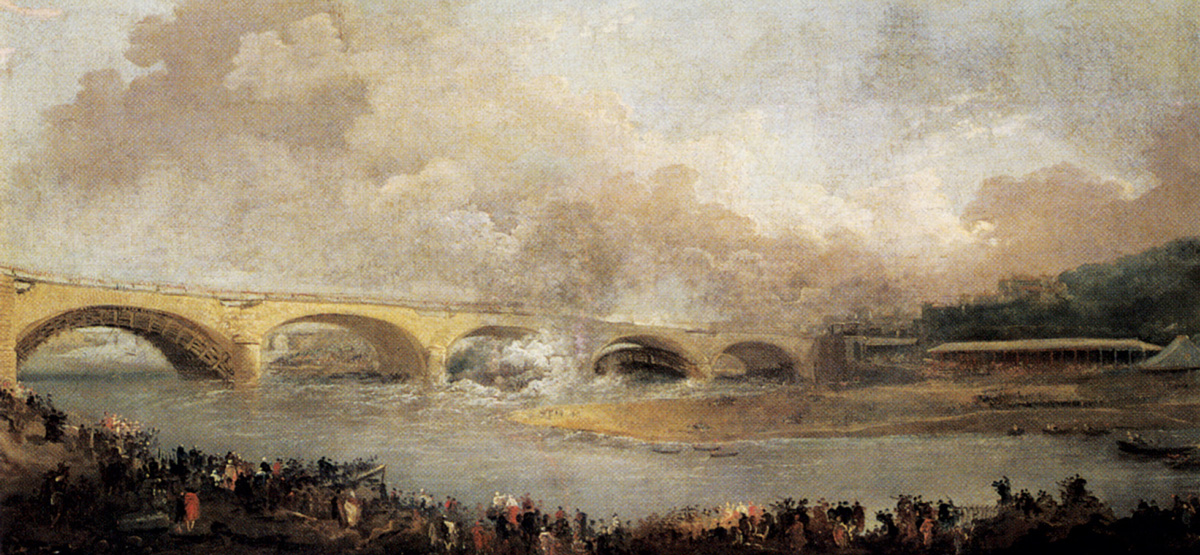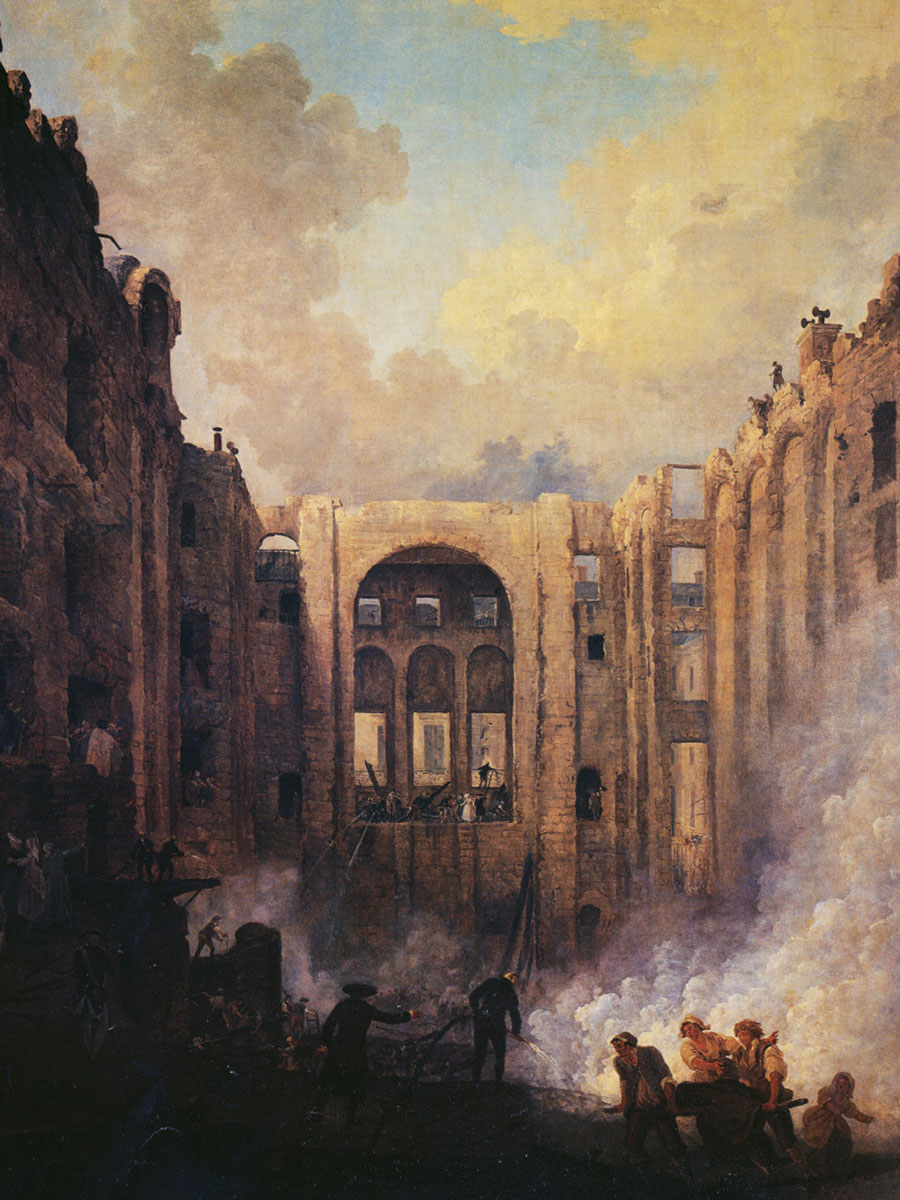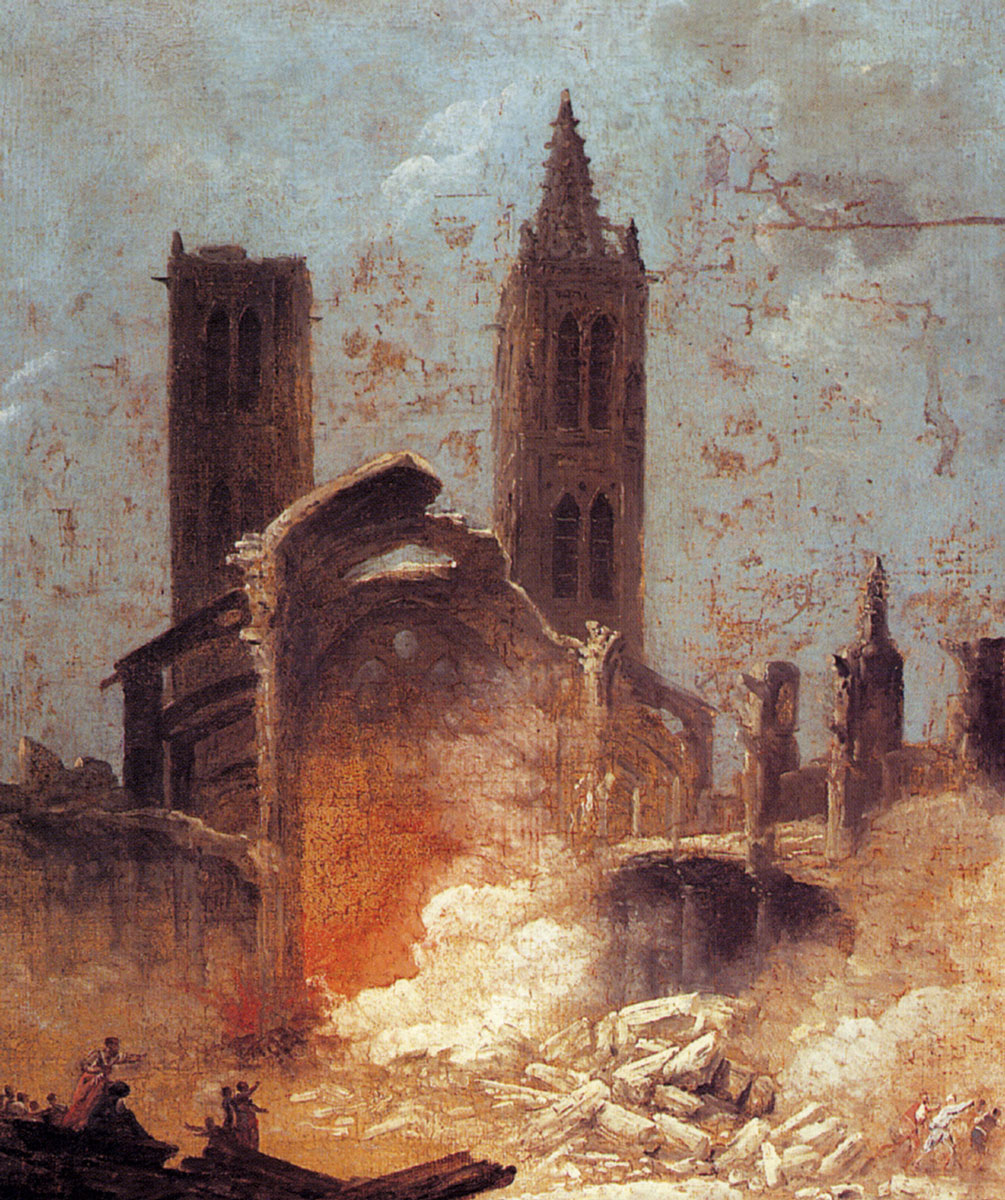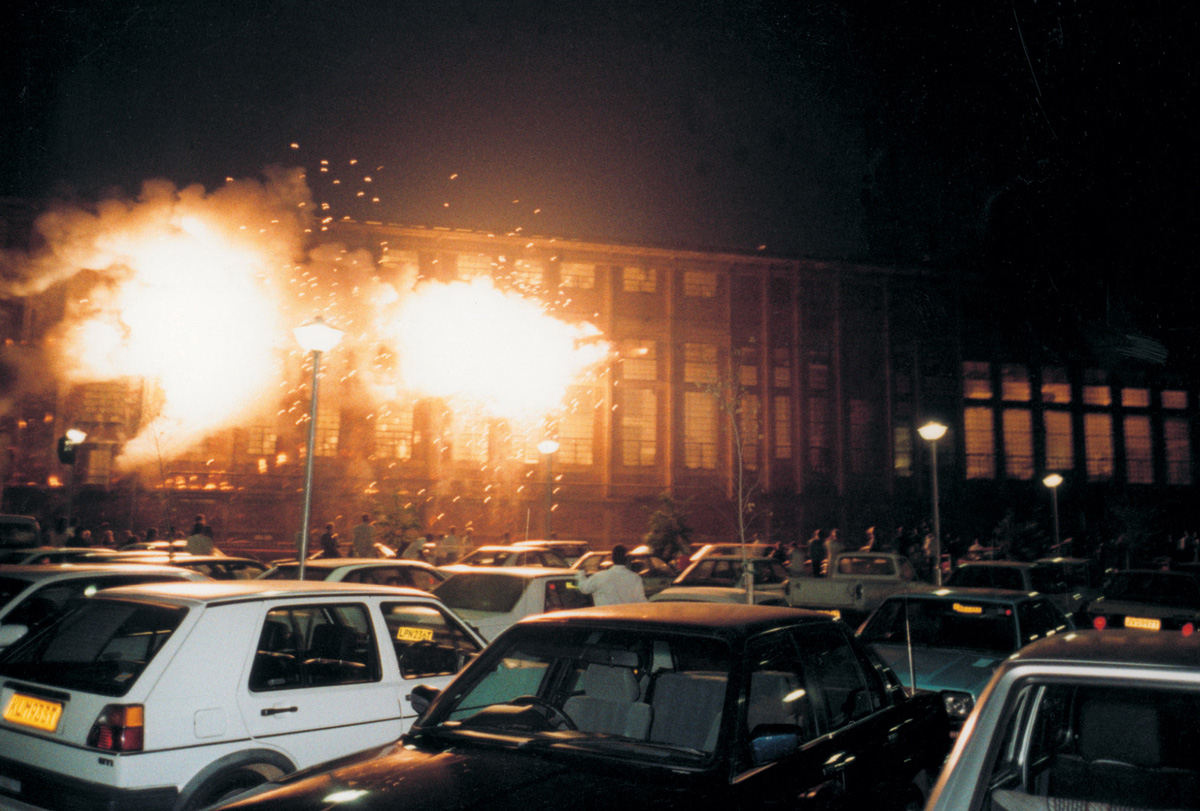Robert des Ruines
Speculating in the market for ruins
Nina Dubin
…we contemplate the ravages of time, and in our imagination we scatter the rubble of the very buildings in which we live over the ground; in that moment solitude and silence prevail around us, we are the sole survivors of an entire nation that is no more. Such is the first tenet of the poetics of ruins.
—Denis Diderot, “The Salon of 1767”
…an “unprecedented” catastrophe can be a far cry from an “unlimited” one.
—Herman Kahn, On Thermonuclear War
For the RAND Corporation intellectual Herman Kahn, to contemplate the future was to court catastrophe. Kahn has been described as avant-garde in his thinking; he might equally be cast as an avatar of the “long eighteenth century.” For it was the age of Diderot that inaugurated our modern fascination not only with the future, but with catastrophe as well—a fascination that appears to have first found expression in the eighteenth-century cult of ruins.
Diderot holds the distinction of formulating the “poetics of ruins,” but he was far from alone in his taste for “ravages” and “rubble.” The author Réstif de la Bretonne relished the “terrifying” spectacle of the 1781 fire at the Paris Opéra, as did the chronicler, Louis Sébastien Mercier, who was held captive by the “horrible and curious” sight.[1] In a 1787 memoir of his trip to Italy, Charles Dupaty described a giant conflagration at Saint Peter’s Square—a “magnificent” event, though entirely fictive.[2] In a century marked by the 1755 Lisbon earthquake and by the discoveries of Herculaneum and Pompeii, artists and writers alike mined the aesthetic interest of unpredictable catastrophe. Among them was Hubert Robert, whose corpus of ruin paintings includes a sub-genre devoted to contemporary urban disasters. Robert launched the series soon after his return to Paris following eleven years in Rome, and it appears that the French capital repaid his interest rather generously. Sketchbook in hand, Robert returned repeatedly to the charred ruins of the hospital at the Hôtel-Dieu, which burned in 1772, and he caused a sensation at the Salon a decade later with two large-scale paintings featuring the fire at the Opéra. Encompassed in this macabre series of “modern ruins” were not just actual disasters, but potential ones as well. In 1772, the completion of a new bridge at Neuilly was the occasion of public fanfare, which Robert recorded from a nearby riverbank. Critics of the engineer Jean-Rodolphe Perronet’s design claimed that the bridge’s piers were too narrow, and the crowd that witnessed the inaugural ceremony, in which the centerings were released climactically into the Seine, is said to have waited breathlessly to see whether the entire edifice would collapse. It is this moment of suspense—the centerings frozen in mid-air, the crash of the waves around the bridge’s piers—that Robert captured in his canvases commemorating the event. The painter’s ultimate degree of exuberance appears to have been reserved, however, for the subject of church demolitions, evidently second in his esteem only to conflagrations. These events occurred with some frequency after 1787, when the Church of the Innocents and its overcrowded cemetery were condemned. In Robert’s Demolition of Saint-Jean en Grève Church of 1800, onlookers marvel at the spectacular explosion of the decaying, fourteenth-century monument, while at right, three figures flee in terror. Such occasions were likely something of a popular attraction. The architect Radel, who was entrusted with the demolition, boasted the skill of knowing how to level a gothic church in ten minutes flat, and proudly exhibited diagrams of his technique at the Salon six years later.
“In every thing sudden and unexpected, we are apt to start,” observed Edmund Burke in his groundbreaking account of the sublime.[3] And yet if ruins have garnered recognition as the eighteenth century’s sublime subject par excellence, it is precisely insofar as they seem to repudiate suddenness. Indeed, as testaments to the persistence of the past, to duration into the future, ruins stirred powerful awareness of the sublime vastness of time. Reviewing Hubert Robert’s Salon debut in 1767, Diderot famously declared: “The ideas ruins evoke in me are grand. Everything comes to nothing, everything perishes, everything passes, only the world remains, only time endures. How old is this world! I walk between two eternities.”[4] It is striking, however, that within a few pages of these solemn reflections the critic observes the effect of the setting sun upon Robert’s paintings, and promptly imagines the Salon bursting into flames—consumed by “a large nearby conflagration that threatened the entire building.”[5] Nothing if not versatile, ruins catalyzed with equal readiness contemplation of eternity and infatuation with exigency. With his renderings of demolition and disaster sites, Robert chronicled the capital’s explosive surrender to the forces of contingency, and made it the basis for an accident-driven account of the sublime. Such representations of urban modernity flouted all rules of academic decorum. Just as strikingly, they were executed during a time of free-wheeling economic uncertainty, and it is as expressions of the wild world of late-eighteenth-century capitalism that they might be considered truly avant-garde.
Though it has scarcely been appreciated, the cult of ruins coincided with the emergence of modern market structures, and market forces appear to have catalyzed an awareness of contingency that eighteenth-century artists and aesthetes brought to bear on their apprehension of ruins. The meteoric rise of “Robert des Ruines”—so called for having cornered that market—is a case in point. As an artist favored by a powerful class of bankers and financiers, Robert enjoyed a proximity to the epicenter of risk that arguably helped shape his distinctive aesthetic sensibility. He became a fanatic for fire-ravaged monuments, after all, at a time when catastrophism constituted the cutting edge in new financial industries. High-stakes gambling on life and fire insurance was a legitimate practice in the last years of the old regime. Financiers floated insurance companies as investment trusts on the Paris Bourse, capitalizing on the lure of risk and novelty, and more profoundly, on a mass willingness to “exchange present certainty for future uncertainty.”[6] The gambling mania benefited not only the stock exchange, but the interests of the French State: in 1776, Louis XVI established the Royal Lottery as an expedient for recovering from the ruinous effects of the Seven Years’ War, and thereafter collected millions of livres in annual revenue with which to finance the national debt and important building operations. Official sponsor of a culture of risk, the state peddled such popular ventures as annuities, or life-contingent incomes that expired upon the death of the person named in the contract. These functioned, in effect, as opportunities to bet on the lives of family members and strangers alike, and, though considered morally suspect, they were avidly consumed by the public. Hubert Robert himself made a small fortune investing in life-contingent contracts. The bank managed by Robert’s patron, Girardot de Marigny, helped broker one of the most notorious outbreaks of the life-betting frenzy, one which culminated in international bereavement with the premature passing of one Pernette-Elisabeth Martin, on whose eighteen-year-old head rested two million livres in investments. Martin had been one of thirty Genevan virgins presented to the public as a sure bet, a subject whose longevity, favored by the laws of probability, would furnish investors with an abiding source of annual revenue from the French government.
What was the valency of ruins in a climate of economic risk? A clue lies in the Abbé de Lubersac de Livron’s 1775 account of the garden at Monceau then being constructed on the capital’s outskirts by the duc de Chartres. The picturesque pleasure retreat was strewn with artificial ruins, among them a crumbling castle that masqueraded as an ancient château, and Lubersac remarked that the structure had “a little too much the air of a property seized long ago and of which the proprietor submits to the creditors and the bailiffs.”[7] This perception of the ruin as the instantiation of unpredictable returns likely had little to do with the duc de Chartres’s sizeable gambling debts, which he would soon seek to reverse by undertaking an ambitious speculative development project around his Paris property. The comment is instructive, though, insofar as it implicates the vogue for ruins within an economy of chance, and more specifically within the vicissitudes of credit. And the dilapidated castle’s connotation of repossessed property appears all the more meaningful, if we consider that the cult of ruins coincided with the rampant growth of the Paris credit market.
“People of Betique, do you want to be rich? Imagine that I am very rich, and yourselves too. Convince yourself each morning that your fortunes have doubled overnight. Then get up and, if you have creditors, pay them with what you have imagined and tell them to imagine in turn.”[8] So intones the villainous progeny of the god of wind in Montesquieu’s Persian Letters, in an episode satirizing the illusions perpetrated by the use of credit. Montesquieu witnessed with horror the upheavals that followed the introduction of paper money. Like other critics of “the papered century,”[9] he equated financial instruments with works of fiction, thus contributing to a literary genre that remains—in today’s Alice in Wonderland scenario of “derivative products” and “debt futures,” to quote a contemporary commentator[10]—decidedly useful. Denounced by Defoe as a “chimera,” and likened by Voltaire to “commerce of the imagination,”[11] credit was condemned not only for sustaining the illusion of wealth, but for veiling a reality of debt. The credit economy, flooded with paper currency and bills of exchange, eroded the distinction between profits and losses, Montesquieu observed; it created “confusion between a circulating paper that represents money or a circulating paper that is the sign of the profits a company has made or will make in commerce, and a paper that represents a debt.”[12] Credit injected uncertainty into the present, and disrupted the linear passage of time by conflating yesterday’s debts and tomorrow’s earnings. Suspended, then, between plenitude and mere potentiality, between past value and future returns, credit exhibited precisely the condition that is the hallmark of the ruin. For it was in the eighteenth century that ruins gained recognition as “configurations of ongoing decline and growth, decomposition and recomposition, erosion and accretion”[13]—as unstable sites of temporal fluctuation. And just as credit existed only on the order of opinion and belief, that is, in absolute porousness to the “unpredictable contingencies and emergencies” of “fortune,”[14] so was the ruin an object of wonder for its symbiotic relationship with nature and exigency.
Visions of ruin, no less than anxiety over credit, reflected a new relationship to the future generated by the eighteenth-century financial revolution. The age abounded in apocalyptic prognostications: “the seeds of ruin are here scattered,” warned Hume of the state’s reliance on public credit.[15] Concerns that luxury would be the nation’s downfall resounded in Mercier’s description of the Paris “building mania,” which he predicted would lead to mass architectural and financial ruin. According to his assessment, given the cheap materials employed by carpenters, all buildings erected in recent decades were doomed to collapse, and in one hundred years, every house would disintegrate.[16] Ruins preyed on the imaginations of risk-averse prophets of doom. Yet, they were also voraciously consumed by a risk-taking milieu that perceived in urban disaster a potential source of profit.




In the middle of the century, Voltaire observed the decrepit condition of the capital, and dreamt of the new city that might be built, “if [only] Paris would burn.”[17] Such sentiments would have delighted the entrepreneurial class. For in the eyes of the city’s real estate speculators, ruins occasioned lucrative building opportunities. Hubert Robert was far from the only Parisian mobilized by the sight of the Opéra in flames. Theater being the national pastime, the demand for theatrical monuments was a key component of the “building mania”: at least thirty were built in Paris alone in the last decades of the eighteenth century. For scores of enterprising architects, real estate speculators, and a wily state minister by the name of Papillon de la Ferté, the loss of the eleven-year-old Paris Opéra (the previous one had burned as well) sparked hopes of rebuilding at a profit. It fell to the King to decide the fate of the public institution, besieged by a flurry of competing interests, and it was Papillon who saw to it that construction rights would devolve to the architect Lenoir, who managed to design a new monument while the old one was still burning. Lenoir, in fact, was a seasoned real estate speculator whose gambles in the business of theater construction would ultimately land him in poverty. In the meantime, however, he succeeded in erecting a new Opéra within a whirlwind sixty-five days, after arranging to build it on property that he—backed by two financiers—had privately come to lease. Lenoir’s company specialized in the buying, developing, and reselling of Paris real estate, and his silent partners included none other than Papillon himself. The minister thus stood to gain from the Opéra’s relocation to the new quarter, where it was certain to raise land values, a fact not lost on the beleaguered Opéra troupe. On the eve of the Revolution, the troupe declared that an inconvenient location had driven the Opéra into bankruptcy, and that the state, in collusion with private interests, had defrauded the public.
Furious trade in government loans and joint-stock shares; frenzied investment in overseas currency; manic manipulation of market values by colluding stock-jobbers who bought on margin and sold short:[18] speculation hit a fevered pitch in the 1780s, and it is before the frenetic backdrop of the Paris Bourse that we might best evaluate the vogue for ruins. In 1787, Mirabeau wrote that the stock exchange had fallen into the hands of dangerous financiers who, “in order to promote their speculations, employ more or less blameworthy ruses, give false information, deceptive advice, say that they sell when they buy, form sham companies in order to turn men into veritable dupes… & in this way cheat turn by turn the government, the public & their accomplices.”[19] In an unhinged marketplace, false values reigned: failure might masquerade as growth, partial bankruptcy was considered a precondition for grandiose profit, and decline could just as easily be a sign of vitality. This phantasmagoric logic, the basis for a speculative economy, takes spectacular form in Hubert Robert’s urban ruins. Exalting unforeseeable collapse, his portraits of the capital’s decimated monuments, it could be said, helped condition their audience to a new order of risk. In glorifying the recent remains of unpredictable disaster, Robert sanctioned a world in which the past no longer provided a reliable compass. And for those socialized to embrace contingency, Robert’s ruins offered gratifying aesthetic returns. Salon critics attacked the painter’s hastily-executed pendants featuring the fire at the Opéra, but the canvases were reportedly the object of a bidding war, and fetched the considerable sum of 2,400 livres each from the wealthy banker, Girardot de Marigny.[20]
Though their production coincided with the advent of insurance, Robert’s urban ruins capture a defiantly uninsurable world, one subject to radical reversals of fortune, fiercely independent from the laws of probability, happily hostage to the caprices of chance. In their rendering, hyperbole was of the essence: Robert inflates the scale of his ruins out of all proportion, dwarfs their human witnesses, and marshals the outmoded trademarks of baroque scenography—gusts of smoke, walls of flame, floating heaps of dust—as if to conjure a city bewitched. “Whatever we mean by modernity,” writes Lorraine Daston, “is linked with new attitudes toward the control of the future and the possibility of a life relatively secure from the disruptions of chance.”[21] Undoubtedly, Robert’s modern ruins exhibit traces of a premodern irrationality, of atavistic resistance to the “Age of Reason.” Yet his paintings might just as aptly be described as hypermodern. The “risk-taking artist” is an icon of modern economic life, notes Randy Martin in Financialization of Daily Life. “Danger, uncertainty, volatility” are necessary “if a creative return is to be realized.”[22] It is thus fitting that Robert’s patrons were pioneers of late-eighteenth-century capitalism. Foremost among them was Jean Joseph de Laborde, banker to Louis XV, a self-made “modern Midas”—in the words of Diderot[23]—and perhaps the wealthiest man in France by the time he was thirty. At about the time of Robert’s return to Paris from Rome, Laborde discovered the profits to be had in urban development, and, “as if by magic,” noted Mercier, transformed the city’s northern marshland into one of the most fashionable quarters of the capital.[24] In a two-decade period the banker purchased and sold dozens of properties and undeveloped lots in the Chausée d’Antin, making the area a centerpiece in the lives of speculative investors. Throughout the capital, however, far less successful building sprees were carried out, and a proliferation of half-finished edifices created the sense of a provisional city haunted, wrote Mercier, by “ruinous fantasies.”[25]
Robert executed his urban disaster paintings during the time of a real estate bubble, and the inflation of land values seems manifestly meaningful to the economy of his paintings. Robert exaggerated the sublime quality of his subjects, and heightened their fear-inducing potential, in keeping with the entrepreneurial logic that the greater the disaster and the higher the risk, the stronger the possibility of incalculable returns. Scholars have noted that the aesthetic of the sublime—with its connotations of “dread,” “danger,” and “darkness,” and its associations, wrote Burke, with “the notions of ghosts and goblins”—came into currency at a time of alarm over the mysteries of financial markets.[26] Prosperity is suspended on the “Daedalian wings of paper money,” wrote Adam Smith, echoing widespread concern over the transubstantiation of real wealth into ethereal fictions.[27] Robert, however, surrendered blissfully to the logic of the bubble. The profusion of vaporous effects in his urban ruins—harbingers of a spectral economy—is yet another sign of his initiation into the cult of risk.
Robert and his contemporaries thus discovered in the ruin a vehicle for grappling not only with real disaster, but with the phantom menaces unleashed by the market’s institutionalization of risk. With Enlightenment in retreat, traces of the eighteenth century can be found in the figure of today’s risk-courting artist. Consider the work of the “gunpowder artist” Cai Guo-Qiang, whose large-scale, accident-prone, pyrotechnic events uncannily mirror the paroxysmal boom and “explosive profits” of his native China, the world’s fastest growing economy. In more ominous ways, however, Robert’s genre has proven prophetic, as the speculative process his age inaugurated has lately culminated in the proposed futures market in terrorism, not to mention the mysterious spike, on 10 September 2001, in share trading on American and United Airlines. Ever more extreme “recourse to the imaginary”[28] is the legacy of the “age of risk,” as is the dark merger of futures and ruins.
- Réstif de la Bretonne, Les Nuits de Paris (Paris, London, and New York: Editions Sambel, 1969), p. 152; Louis Sébastien Mercier, Le Tableau de Paris (1781–1788), Jean-Claude Bonnet et al., eds. (Paris: Mercure de France, 1994), vol. 1, chapter CXXIV, p. 298.
- Charles-Marguerite-Jean-Baptiste Mercier Dupaty, Lettres sur l’Italie, en 1785, 3rd edition (Paris: Jean Mourer, 1796), pp. 238–243.
- Edmund Burke, A Philosophical Enquiry into the Origin of our Ideas of the Sublime and Beautiful [1757] (Oxford: Oxford University Press, 1990), p. 76.
- Denis Diderot, “Salon of 1767,” in Diderot on Art, vol. II, ed. and trans. by John Goodman (New Haven and London: Yale University Press, 1995), pp. 198–199.
- Ibid., p. 208.
- Lorraine Daston, Classical Probability in the Enlightenment (Princeton: Princeton University Press, 1988), p. 117; see also Gerda Reith, The Age of Chance: Gambling in Western Culture (London and New York: Routledge, 1999).
- In Discours sur les Monuments Publics de tous les âges et de tous les peuples connus (Paris, 1775), p. lviij; trans. in David L. Hayes, “‘This is not a Jardin Anglais’: Carmontelle, the Jardin de Monceau, and Irregular Garden Design in Late-Eighteenth-Century France,” in Villas and Gardens in Early Modern Italy and France, ed. Mirka Benes and Dianne Harris (Cambridge: Cambridge University Press, 2001), p. 302.
- Charles de Secondat de Montesquieu, Les Lettres Persanes [1721], Lettre 142; cited and trans. in Thomas M. Kavanagh, Enlightenment and the Shadows of Chance: The Novel and the Culture of Gambling in Eighteenth-Century France (Baltimore and London: Johns Hopkins University Press, 1993), p. 84.
- The locution is Johann Büsch’s; cited in Marc Shell, Art & Money (Chicago: The University of Chicago Press, 1995), p. 66.
- Joel Kurtzman, The Death of Money: How the Electronic Economy Has Destabilized the World’s Markets and Created Financial Chaos (New York: Simon and Schuster, 1993), p. 19.
- Daniel Defoe, The Chimera, or The French Way of Paying National Debts Laid Open (London, 1720); J. F. M. Arouet de Voltaire, Oeuvres historiques (Paris, 1957), p. 1311. Cited in Shell, Art & Money, p. 68.
- Charles de Secondat de Montesquieu, The Spirit of the Laws, trans. by Anne Cohler, Basia Miller, and Harold Stone (Cambridge: Cambridge University Press, 1989), p. 418.
- Nick Yablon, “The Metropolitan Life in Ruins: Architectural and Fictional Speculations in New York, 1909–1919,” in American Quarterly, June 2004, vol. 56, no. 2, p. 336.
- J. G. A. Pocock, “Modes of Political and Historical Time in Eighteenth-Century England,” in Virtue, Commerce and History: Essays on Political Thought and History, Chiefly in the Eighteenth Century (Cambridge: Cambridge University Press, 1985), pp. 91–92.
- David Hume, “Of Public Credit,” Essays moral, political and literary, ed. T. H. Green and T. H. Grose (London: Longmans, Green, and Co., 1875), vol. 1, p. 367.
- Tableau de Paris, vol. 2, chapter DCXXXIX, p. 390.
- J. F. M. Arouet de Voltaire, Des embellissements de Paris [1749], ed. Mark Waddicor, The Complete Works of Voltaire (The Voltaire Foundation, Taylor Institution: Oxford, 1994), pp. 231–232.
- See George V. Taylor, “The Paris Bourse on the Eve of the Revolution, 1781–1789,” in The American Historical Review, April 1962, vol. LXVII, no. 3, pp. 951–977.
- Honoré-Gabriel de Riquetti, comte de Mirabeau, Dénonciation de l’agiotage au roi, et a l’Assemblée des notables [1787], p. 29; trans. in ibid. p. 955.
- See Paula Rea Radisich, “Hubert Robert’s Paris: Truth, Artifice, and Spectacle,” in Studies on Voltaire and the Eighteenth Century, no. 245, 1986, p. 501.
- Lorraine Daston, Classical Probability in the Enlightenment, op. cit., p. 164.
- Randy Martin, Financialization of Daily Life (Philadelphia: Temple University Press, 2002), pp. 112–113.
- Salon de 1769, in Diderot Salons, ed. Jean Seznec and Jean Adhémar, 2nd ed., (Oxford: Clarendon Press, 1975), vol. IV, p. 89.
- Le Tableau de Paris, vol. 1, chapter LXXXVIII, p. 224.
- Le Tableau de Paris, vol. II, chapter DCCLXXVI, pp. 811–812.
- See Patrick Brantlinger, Fictions of State: Culture and Credit in Britain, 1694–1994 (Ithaca: Cornell University Press, 1996), pp. 108–109, and Peter de Bolla, The Discourse of the Sublime: Readings in History, Aesthetics and the Subject (Oxford and New York: Basil Blackwell, 1989), pp. 103–140.
- Adam Smith, The Wealth of Nations; cited in Brantlinger, Fictions of State, op. cit., p. 88.
- Richard Dienst, “The Futures Market: Global Economics and Cultural Studies,” in Reading the Shape of the World: Toward an International Cultural Studies, Henry Schwartz and Richard Dienst, eds. (Boulder: Westview Press, 1996), p. 74.
Nina Dubin is completing a dissertation on Hubert Robert in the Department of the History of Art at the University of California, Berkeley. She is currently a fellow at the Getty Research Institute in Los Angeles.
Spotted an error? Email us at corrections at cabinetmagazine dot org.
If you’ve enjoyed the free articles that we offer on our site, please consider subscribing to our nonprofit magazine. You get twelve online issues and unlimited access to all our archives.